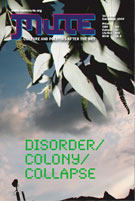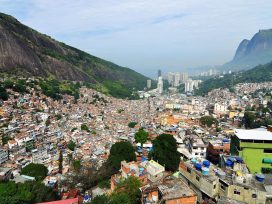City of zombies
 The film I Am Legend (2007) presented military scientist Robert Neville as the last man alive in an abandoned Manhattan. Working on a cure for a global zombie pandemic, he hasn’t seen another human for nearly three years. He drives around with his dog, hunts deer with a rifle, plays golf from the wing of a rusting SR-71 Blackbird. Sometimes he converses with mannequins in his local video store. In the evening he uploads new songs to his iPod.
The film I Am Legend (2007) presented military scientist Robert Neville as the last man alive in an abandoned Manhattan. Working on a cure for a global zombie pandemic, he hasn’t seen another human for nearly three years. He drives around with his dog, hunts deer with a rifle, plays golf from the wing of a rusting SR-71 Blackbird. Sometimes he converses with mannequins in his local video store. In the evening he uploads new songs to his iPod.
A conventional tactic for interpreting horror films is to translate the fantastical elements back into realism. Perhaps there are really no zombies at all, but only an alienated man living an isolated existence? Technology aims, like a smart bomb, at the horror of being. I Am Legend loses its being (like the verb to befriend has become to friend) and turns into iLegend, like iMac.
Some stories return until shot in the head. iLegend drew its source material from Richard Matheson’s 1954 novel, a book which has been adapted for film twice before. In the original text Robert Neville battles sentient vampires before conceding defeat with the birth of a new race. In the Hollywood film adaption The Omega Man (1971), Charlton Heston faced a Manson-like cult, over which he eventually triumphed in death. In both the 1971 film and the original book, the agent of genetic mutation is a mysterious plague which arrives from the outside, like divine violence. In the more Faustian new film, the pandemic is an unforeseen side-effect of a new cure for cancer.
Human civilisation’s techno-scientific ambitions bring about the destruction of human civilisation. In the era of climate change, the ecological subtext is clear. It’s not just an issue of industrial pollution. The concept of climate change embraces shifts in the mediascape; over the last 30 years this landscape has altered. Before the birth of the internet, culture transmitted through interpersonal networks condensed into a series of key physical nodes: record shops, bars and cafés, bookstores and social centres. All of these areas are now being liquidated, as the economics of an immaterial world start to bite.
The result is a depletion in public space, both mental and real. In Comments on the Society of the Spectacle, Guy Debord lamented the new situation. “For the agora, the general community, no longer exists […] no place where people can discuss the realities which concern them, because they can never lastingly free themselves from the crushing presence of mediatic discourse.” In the age of the world picture, the “great Outside” is screened out; individuals become sealed inside segregated realities, fed by wire pipes of specifically calibrated information. Everyone at the centre of their own virtual universe. Every bastard a king.
The operating system is a pattern of identity, or ideological branding. Debord’s recurrent polemics against the phantom-brand of Situationism represented an attempt to escape from this prison. But whenever two or more Situationists were gathered in that name, Situationism was already in their midst. This self, and this tribe, and this set of commitments…
Rhetorical protocols – shibboleths – hook onto the world, shaping it into a sign system, as if being itself murmured meaning and the inert whispered speech. “[F]or any Arab who cares to think about it,” Enzensberger remarks in his 2005 essay “The radical loser”, drawing on contemporary geopolitical metaphors, “the very objects on which everyday life in the Maghreb and the Middle East depends represent an unspoken humiliation – every fridge, every telephone, every power socket, every screwdriver, not to mention hi-tech products.” The claim – psycho-cultural rather than racial – turns on the idea of a produced alienation: a clash between “civilisations” staged in an internal theatre, generated by a dynamic scenography.
The Moscow-born media theorist Lev Manovich has imagined a future in which “every object may become a screen connected to the Net, the whole of built space becoming a set of display surfaces.” Every sight will beam back a factory-installed persona, carried under the breath of a libidinal charge. Humiliation summons a projection made earlier: in this case an internalised (Arab) identity, throwing (external) reality into sharp negation.
Humiliation + Identity = Radical Loser. It isn’t clear where the seat of this process is located. But what is clear is that interface bandwidth is skyrocketing. Tethered information appliances like iPods and iPhones are only the peaks of a global media iceberg. The complex advances with every innovation, towards a point of complete articulation. Signals and bodies cease to be strictly distinguishable, as everyone becomes the carrier of a specifically conditioned charge. Image speaks across oceans to image, signal to signal, station to station…
Enzensberger defines the loser as “the isolated individual”. In a world in which all life starts in public (and ends with the one mess that you cannot clean-up), isolation is a synthetic condition. Isolation is carved-out. Surgery involves costs. iLegend employed the fast moving zombies last seen in Zach Snyder’s 2004 remake of George A. Romero’s Dawn of the Dead and Danny Boyle’s social realist visions of Britain, the 28 (X) Later films. The creatures embody the flip-side of a total environment that is less a real city than a virtual environment coded to look like one. The former is a space of encounters, intimate revolutions, sudden exposures. The latter is a frozen world of static. Immersed in the amniotic embrace of communications technology, which offers the promise of surfing on your interests forever, the full spread of a user’s psychic demands can be met.
The hierarchy of needs finally culminates with the desire-named-Christ: iLegend concludes with the obsessional Neville sacrificing his blood (in the course of synthesising a cure) so that humanity may be healed and redeemed. Inside the secured borders of a personalised dreamworld, other users acquire the appearance of obstacles, or skandalons: the Greek term for stumbling-blocks from which the name Satan derives. Evil starts to speak to evil, and desire is turned towards a search for the murder weapon, or skandali, the feminine form of the word, referring to the trigger of a gun.
In his 2003 essay “To Love, to Love Me, to Love Us” the French philosopher of technology and reformed armed robber Bernard Stiegler supplies a more technical summary of the psychological circuit. Written in the aftermath of the murder of eight people in Nanterre’s town hall by the local activist Richard Durn in 2002, Stiegler describes Durn as suffering from a deficit of “primary narcissism”. The murderer saw in the municipal council “the reality of an alterity that made him suffer, that did not return to him any image, and he massacred it.”
Stiegler contends that the planet is Durnising. What is emerging is “neither singular identity nor relations; only solitude and similitude” in a universe where every individual is becoming increasingly embroiled “in a silent dialogue […] with the landscape-text addressed to him along with others” and within which “the only face to be seen, the only voice to be heard […] are his own: the face and voice of solitude made all the more baffling by the fact it echoes millions of others.” The organising idea is the narcissus myth, diagnosed by McLuhan with respect to Isaac Newton (“a hypnotised, narcissus type”) and later analysed more directly by the cultural critic Christopher Lasch as the primary social symptom of capitalism.
“Blake spoke,” writes McLuhan, “of the need to be delivered ‘from single vision and Newton’s sleep,’ knowing very well that Newton’s response to the challenge of the new mechanism was itself merely a mechanical repetition of the challenge.” “I fear all this is merely the beginning,” warns Stiegler, “of a long and arduous path. On this path one must cast all doubt aside to fight the imminent possibility of the total atomization of the we.” The programmes are in some sense opposed. Durn’s murderous action may itself be appreciated as a desperate last stand against atomisation. The “we” strings itself between the “I” and the “them”; between the abject and inchoate enemy and the projection of desire onto a collective identity. Enzensberger describes a vicious psychological circuit: “It’s my fault.” – “The others are responsible.” “These two claims,” Enzensberger asserts, “are not mutually exclusive. On the contrary, they reinforce each other. The radical loser is unable to think his way out of this vicious circle, and it constitutes the source of his terrible power.” Sometimes the sole remaining course of action is casting all doubt aside and exterminating the brutes.
City of webs
“Between the nineteenth and the twentieth centuries between Simmel and Weber, Burckhardt and Braudel,” writes Antonio Negri, “the city had become polis again, the imperial centre. Now space and time destroy this utopian centrality.” Every paradise is a lost paradise. It is hard to know if “the city” ever really possessed this status. What is clear is that the contemporary world is more urbanised then ever before. According to statistics compiled by the Urban Age Project for the London School of Economics and Deutsche Bank’s Alfred Herrhausen Society, 10 percent of the world lived in cities in 1900, 50 percent became urbanised by 2000, and a projected 75 percent of global population will be urban by 2050.
This new urban landscape is crucially different to the urban space which preceded it. The largest cities of 1900 belonged to the major world powers: London (6,480,000), New York (4,242,000), Paris (3,300,000), Berlin (2,707,000), Chicago (1,717,000). As of 2007, the New York metropolitan area retained second place (17,800,000) behind Tokyo/Yokohama (33,200,000), but seven of the eight remaining cities in the global top ten were all located in the global South.
The city of the future will resemble Lagos more closely than London. In his book Concrete Reveries, Mark Kingwell takes a page from Walter Benjamin, naming New York as capital of the twentieth century, overtaking Paris, the capital of the nineteenth. At the peaks of their prominence, both the City of Light and The Seat of Empire (© George Washington, 1784) incarnated and symbolised planetary dreams. Every epoch dreams its successor. The destruction of the World Trade Center in September 2001 brought the era of New York’s unquestioned urban supremacy to a close. The North East blackout which descended on the city two years later represented the requiem. The economy runs on symbolic authority like a car runs on gas. In a matter of hours, world trade became hollow. Ground zero replaced the twin towers, creating the context for the recent financial crisis.
Twentieth century New York played host to a specific urban form: The Grid. “[T]he Grid’s two-dimensional discipline,” Rem Koolhaas remarks in Delirious New York, “create[d] undreamt-of freedom for three-dimensional anarchy.” The grid divided Manhattan into manageable blocks, supplying objective guidelines for inhabiting urban space, transparent in principle to all interested parties. Emblematically liberal, the Grid bridged the antimony between freedom and security, in the process establishing a political-conceptual template for action. A grid for experience, a template for being. Writing on Walter Benjamin, Gertrud Koch remarks: “The grid provides spatial orientation – it structures the space of the earth’s surface in terms of latitude and longitude – but it also contains datelines; the spatial model thus also determines temporal boundaries.” The Grid underpinned the real exercise of imperialism drawing the maps for merchant capitalist conquest. On the other hand, it also determined conceptual boundaries, dividing academic research across specialisms, dividing assembly lines into specialised roles.
The grid and its certainties is what Negri mourns. Geometric and planar, horizontal and rational, from Malevich to Mondrian, the Grid embodied the state of the modernist political-technological art, which was a disciplinary art. But as the societies of discipline morphed into the societies of control, the “architecture of borders, walls, doors, and locks give way to that of passwords, fire walls, public key encryption, and security certificates.” Modernist culture, organised by the grid (and its subjective correlate: the enlightened master) succumbs to a thousand niche-market cuts, whipped raw by Chris Anderson’s “long tail” and decomposed into tribes by Mark J. Penn’s “microtrends”. The grid mutates into the web, the imperial/utopian into the molecular/heterotopian. The new media-architecture begins to manipulate smaller units. The birth, from the ruins, of the negative centre, issues the coup de grâce. The centre is robbed of its sovereignty.
The iron-willed dictator is a thing of the past,” notes William Burroughs. “We have a new type of rule now. Not one-man rule, or rule of aristocracy or plutocracy, but of small groups elevated to positions of absolute power by random pressures and subject to political and economic factors that leave little room for decision.” Hegel writes of the function of kingship as consisting in dotting the i’s and crossing the t’s. No system can close itself off using only elements internal to it. The function of the sovereign (what Foucault terms the author-function) was to supply the seal of transcendence. Twentieth century dictators, captured by cameras and connected with telephones, pumped up the volume.
“The age demanded an image,” notes Ezra Pound, “of its own accelerated grimace.” Placed in the heavens of a vertical hierarchy, the iron willed dictator conducted and channelled the psychologies of his followers: The Father of the Nation. But the death of God, pronounced by Nietzsche at the end of the nineteenth century, was the death of transcendence; the death of the possibility of an absolutely transcendent image. The “age of extremes” was a reaction-formation, against Gödel’s incompleteness theorem, against Nietzsche’s nihilism. Modernism was an ideology of reaction, which grafted the forms of the past onto new contents (Stalin the Red Tsar, Hitler the Sorcerer-Emperor…) and then stood back, aghast, as the host rejected the transplant.
The invention of digital technology ended this period of ideological frenzy. “As the Enlightenment and ‘modernity’ were increasingly called into question,” writes Peter Wollen, “a process accelerated by post-1968 disenchantment, French intellectuals turned away from ‘knowledge-based’ approaches to the humanities and towards the more speculative domains, urging a decentralised vision of ‘dissemination,’ ‘rhizomes’ and ‘molecular’ microstructures.” Replacing Stalin and Hitler are “Enterprise Systems”, computerised content management systems which cross organisational boundaries, and actualise the potential which the panopticon once contained.
Disciplinary power was based on anxiety; prisoners could never be certain whether the watchtower was occupied. Citizen-subjects today can be sure; the prisoners are now watching each other. “In sales organisation,” reports Richard Sennett, “‘sales reps’ performances can be mapped in real time on home-office computer screens.” Instead of a centralised point of imaginary control; a distributed network of leveraged eyeballs. In The Future of the Internet Jonathan Zittrain describes how these procedures have been employed by the Texas Sheriff’s Office to watch the Mexican-American boarder:
webcam feeds were sent to a public Web site, and people were invited to alert the police if they thought they saw suspicious activities. During the month-long trial the Web site took in just under twenty-eight million hits […] The site registered over 220,000 users, and those users sent 13,000 e-mails to report suspicious activity.
“Architecture,” claimed Mies van der Rohe, “is the will of an epoch translated into space.” The new architecture of power creeps into homes and offices, locking the door to connect to a server in Moscow, shattering the self through the proliferation of windows, and syncopating the rhythm of the public/private divide. “[O]ur societies,” argues Manuel Castells, “are increasingly structured around a bipolar opposition between the Net and the Self.” In reality, the Self and the Net are increasingly intertwined with the other, in a matrix of unconscious allegiances and angled exposures.
The coils of a serpent are more complex than the burrows of a molehill. The subject of power turns into a snake-charmer. At the heart of the web is the spin doctor, grabbing quanta of power by operating on networks. Rather than Stalin, there is Alistair Campbell, managing the media through the use of “Downing Street Grids”; itemised spreadsheets of media movements. “This elaborate construction encompassed not just events in Whitehall but everything going on in the world,” reported the Mail on Sunday in June 2005, “from Parliamentary announcements to pop concerts. Campbell’s aim was to take advantage of them all to paint the Government in the best light.” The spin doctor paints with the news cycle; “Art + Politics = Power”, Hitler scrawls at one point in the 2002 film Max, as lightning cracks in the background. It’s no longer a question of having power, or even embodying power (“I’m not the story”, Campbell used to insist) but channelling power for short periods of time; pulling strings.
Theme park city
In 1967, Marshall McLuhan observed: “the city no longer exists except as a cultural ghost for tourists.” The remark supplies a succinct general formula for the most powerful dyad in contemporary urban theory: the tourist and the theme park.
In his essay “The city in the age of touristic reproduction”, Boris Groys traces the tourist back to Kant’s Critique of Judgement before aligning it with the view of a satellite. In the same essay he argues that the theme park is more primary: “[P]resent-day urban architecture has now begun to move faster than its viewers. This architecture is almost always already there before the tourists arrive. In the race between tourists and architecture it is now the tourist who loses. Although the tourist is annoyed to encounter the same architecture everywhere he goes, he is also amazed to see how successful a certain type of architecture has proved to be in a wide range of disparate cultural settings.” The theme park arrives first, because it is finally immaterial; the power which it exerts is finally a virtual power. The power of the virtual.
It arrives even sooner than the city itself. In Delirious New York, Koolhaas argues that the idea of the theme park was ingrained in Manhattanism from the very beginning, flowing across the East River from the “fetal” Manhattan of Coney Island through the “technology of the fantastic” which it pioneered. From one island to another, this technology was directed towards closing off and bounding space.
This is the death drive of the new media. In March 2009, George Washington University political scientists Eric Lawrence, John Sides and Henry Farrell published a research paper which demonstrated that “[b]log authors tend to link to their ideological kindred and blog readers gravitate to blogs that reinforce their existing viewpoints. Both sides of the ideological spectrum inhabit largely cloistered cocoons of cognitive consonance, thereby creating little opportunity for a substantive exchange across partisan or ideological lines.” The internet is creating a mediarchipelago. The world becomes global by shattering into spheres, linked across space by specified network control channels, with membranes proliferating to keep milieus self-enclosed.
Towards network architecture
Modernism proposed one strategy against the theme park: criticism. But there are doubts as to whether criticism still retains its dynamism. “In truth,” Rem Koolhaas remarked to Der Spiegel in 2008, “the constant return of this Disney fatwa says more about the stagnation of the West’s critical imagination than about the cities on the Gulf.” In Montreal 14 years earlier, Koolhaas was even clearer: “The problem with the prevailing discourse of architectural criticism is the [inability] to recognise [that] the deepest motivations of architecture […] cannot be critical.” The deepest motivation of architecture is performative. In a recent essay, Marion von Osten quoted an unnamed tour guide on the ways in which “public spaces, architecture, and interiors have been so thoroughly appropriated by the people” in postcolonial Casablanca. “We are all engineers,” the man stated, “we are all architects. If we have a basic structure or land, we just start to build.” Van Osten comments: “This surely marks a relationship to one’s environment that is almost forgotten in western societies: that we are all architects.”
We are architects in an environment of “networked ecologies, a series of co-dependent systems of environmental mitigation, land-use organisation, communication and and service-delivery […] produced by technology, laws, political pressures, disciplinary desires, environmental constraints and a myriad other pressures, tied together with feedback mechanisms.” Architecture is an immanent system, operating through discourse, inscribed into bodies, switched through a matrix of passwords and protocols, alternatively enabling and throttling channels. “[N]etworked ecologies,” Varnelis writes, “embody the dominant form of organisation today, the network, but these networks can be telematic, physical or even social.” Varnelis identifies One Wilshire, a cable stuffed communications hub in downtown LA, as the architectural avatar of the contemporary global matrix. “One Wilshire’s form doesn’t matter,” writes Varnelis, “what matters is how it’s been programmed.”

 The film I Am Legend (2007) presented military scientist Robert Neville as the last man alive in an abandoned Manhattan. Working on a cure for a global zombie pandemic, he hasn’t seen another human for nearly three years. He drives around with his dog, hunts deer with a rifle, plays golf from the wing of a rusting SR-71 Blackbird. Sometimes he converses with mannequins in his local video store. In the evening he uploads new songs to his iPod.
The film I Am Legend (2007) presented military scientist Robert Neville as the last man alive in an abandoned Manhattan. Working on a cure for a global zombie pandemic, he hasn’t seen another human for nearly three years. He drives around with his dog, hunts deer with a rifle, plays golf from the wing of a rusting SR-71 Blackbird. Sometimes he converses with mannequins in his local video store. In the evening he uploads new songs to his iPod.




